P-262 thunderkitty!

The Curtiss P-262 Thunderkitty was produced by integrating stolen, then retrofitted German jet technology into the existing airframe of the P-40 KittyHawk. Substansial hardening of the airframe was required to produce the P-262, and while a 3 engine version was built and flown only as a prototype, the 2 engine version saw over 250 produced, and were assigned to squadron duty in the Pacific theatre starting in February of 1945.
Suprisingly, the P-40 airframe adapted quite well to the jet technology, and was later used as a test plane during testing for the F-86 Sabre
which was based almost completely upon its design.
General characteristics
Crew: 1
Length: 31.67 ft (9.66 m)
Wingspan: 37.33 ft (11.38 m)
Height: 12.33 ft (3.76 m)
Wing area: 235.94 ft² (21.92 m²)
Empty weight: 4,404 kg (9,709 lb)
Loaded weight: 7,130 kg (15,720 lb)
Max takeoff weight: 6977 kg (15,381 lb
Powerplant: 2Χ Lockheed Martin 004 B-1 turbojets, 8.8 kN (1,980 lbf) each
Performance
Maximum speed: 900 km/h (559 mph)
Range: 650 mi (560 nmi, 1,100 km)
Service ceiling: 11,450 m (37,565 ft)
Rate of climb: 1,200 m/min (3,900 ft/min)
Thrust/weight: 0.28
Armament
Guns: 5 Χ .50 in (12.7 mm)
Cannons: 2 Χ 37mm Cannon
Bombs: 250 lb (113 kg) to 1,000 Ib (453 kg), a total of 2,000 lb (907 kg) on three hardpoints (one under the fuselage and two underwing
<S> AKP